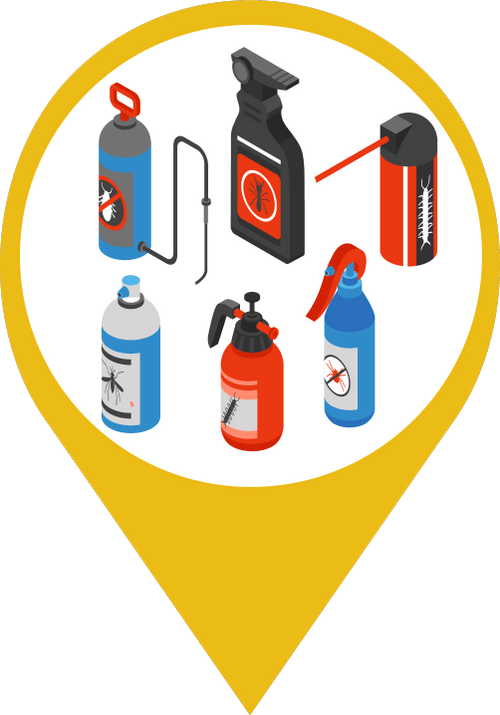Pesticides
Pesticides
Also known as insecticides, herbicides, fungicides, weed killer, crop protection products. 
What are they?
Pesticides are chemicals or biological agents that deter, incapacitate, kill, or otherwise discourage pests. Pests can be plants, animals, insects and fungi. Substances that target microorganisms (including wood preservatives and laundry additives) can also be considered pesticides. Some pesticides take many years to degrade naturally and can therefore move through the environment, including into the food chain.
The Stockholm Convention on Persistent Organic Pollutants (2004) is an international agreement signed by many countries (including Canada) to restrict the use of a list of chemicals that are damaging and long lasting in the environment. Most substances on the list are pesticides.
Are pesticides in water regulated in Alberta?
Some of them are, yes. The Environment Protection and Enhancement Act regulates pesticide use, handling and storage in Alberta. The Government of Alberta has four levels of restrictions for pesticides, with certain regulations for purchase and use. An information overview can be found here.
The Alberta Surface Water Protection Guidelines have identified threshold levels for many specific pesticides in water. There is a separate guideline for protection of aquatic life and for water used in agriculture.
Are pesticides in my water?
Source Water
Pesticides are relatively prominent in surface water in Alberta and have been detected in the Bow River Basin. The most recent study performed by Alberta Environment and Parks found that pesticides were detected in over half of the surface water samples taken from all over Alberta. In most cases, the amount of pesticide found in the water was below the maximum allowable concentration as set out in the applicable Surface Water Quality Guidelines. The guidelines, such as those for the protection of aquatic life, irrigation, and drinking water, were exceeded in less than a third of the samples. Out of 30 sites and 406 samples on the Bow River, 192 samples contained pesticide measurements that exceeded Alberta Surface Water Quality Guidelines.
Pesticides are moderately common in groundwater. A study in the USA from 1997-2001 shows that only about 50% of groundwater wells contained one or more pesticide compound. (U.S. Geological Survey)
Tap Water
With hundreds of pesticides in use today, and water treatment processes unable to remove all of them, there are small amounts of pesticides in tap water.
What are the impacts on human health?
The Guidelines for Canadian Drinking Water Quality include thresholds for maximum acceptable concentrations of several pesticides. These are set because negative human health impacts have been proven to result from some pesticides. Some pesticides have an impact on neurological function or development, and the functioning of certain organs.
What are the impacts on the environment?
Pesticides can be toxic to birds, fish, beneficial insects and non-target plants. Insecticides are generally the most acutely toxic class of pesticides, but herbicides can also pose risks to non-target organisms. Overuse of pesticides affects soil organisms (similar to how the overuse of antibiotics affects humans). Indiscriminate use of pesticides might be effective for a few years, but over time, there are a reduced number of beneficial soil organisms (those that hold onto the nutrients).
How do pesticides get into the water?
Pesticides are applied to crops, gardens, homes, and other situations where certain weeds, fungi, animals, or insects are considered a problem. Pesticides are often sprayed onto the crops from the air, which means particles can be blown by wind and deposited on surface water.
After being applied, pesticides can also be carried by rain into irrigation ditches, streams and rivers. For households, pesticides used in gardens and parks can also be carried by rainwater into the storm drain system.
What can we do about pesticides in the water?
Use alternatives to pesticides in your garden and home.
Encourage local school and municipal landscapers to reduce or eliminate pesticide use.
Choose food items that have been grown where pesticide use is well regulated, or choose foods that were grown without the use of pesticides.
Speak with members of your community and local government about changing land management practices to safeguard local water supplies.
Where can I find more information?
Pesticides in Alberta’s Agricultural Watersheds
National Pesticide Telecommunications Network Factsheet
Canadian Drinking Water Quality Guidelines:
Sources:
Alberta Environment and Parks (2017). Surface Water Quality Program http://aep.alberta.ca/water/programs-and-services/surface-water-quality-program/default.aspx
Byrtus, G., Pongar, K., Browning, C., Burland, R., McGuinness, E., & Humphries, D. (2004). A Summary of Pesticide Residue Data from the Alberta Treated Water Survey, 1995-2003. Alberta Environment.
Anderson, A. (1995). Overview Of Pesticide Data In Alberta Surface Waters Since 1995. Alberta Environment.
Knauer, K. (2016). Pesticides in surface waters: a comparison with regulatory acceptable concentrations (RACs) determined in the authorization process and consideration for regulation. Environmental Sciences Europe, 28(1), 13. https://www.ncbi.nlm.nih.gov/pmc/articles/PMC5044964/
Phelan, C. and Lorenz, K. (2012). Pesticides in Alberta’s Agricultural Watersheds, Irrigation and farm Water Division. http://www1.agric.gov.ab.ca/$Department/deptdocs.nsf/all/irr14259/$FILE/pestinabagwatersheds_factsheet.pdf
U.S. Geological Survey (2006). Pesticides in the Nations Streams and Groundwater, 1992-2001 – A Summary. U.S. Department of the Interior. https://pubs.usgs.gov/fs/2006/3028/pdf/fs2006-3028.pdf
Aktar, M. W., Sengupta, D., & Chowdhury, A. (2009). Impact of pesticides use in agriculture: their benefits and hazards. Interdisciplinary Toxicology, 2(1), 1–12. https://www.ncbi.nlm.nih.gov/pmc/articles/PMC2984095/
